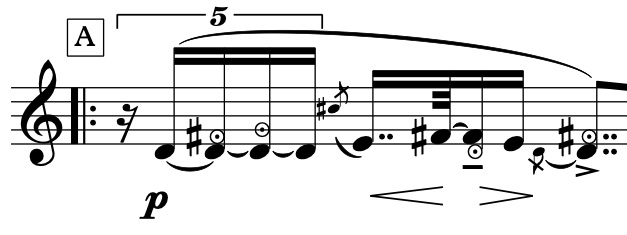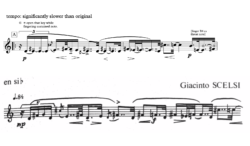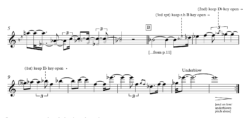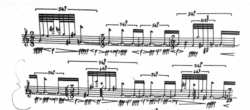Cover versions

Blogging has been a bit slack in 2020, so I'm getting back on board by putting up some things that were worked on earlier in the year.
The initial project stage (Sept–Dec.) was almost entirely open-ended research with Heather (and Jon) exploring the possibilities of the instrument. So to get myself back into composition proper I decided to do some 'cover versions', taking other pieces and re-writing them with new techniques.
The two pieces I chose for this (somewhat arbitrarily, and because I like them) were Bryn Harrison's Open 2 and Giacinto Scelsi's Preghiera per un' Ombra. These pieces were also chosen because they're both in Heather's repertoire so they're already 'under the fingers'; though learning to play a known piece in a totally different way is arguably more difficult than a completely new piece.
The Scelsi piece came first. The basic technique I wanted to try here was to take standard fingerings and alter them to introduce indeterminacy; i.e. open up the possibility (not absolutely certain in any case) that the fingerings might each afford several different single- and multiple-sounds. The alterations take several forms, outlined below, fig.1 shows an example of the first few bars compared with the Scelsi original.

fig.1: comparing opening bars of my score and Scelsi original.
The notation attempts to reduce complexity by showing the basic fingering as normal, and using 'ping' noteheads to show what additional key/hole should be opened or applied: this requires some careful consideration because sometimes this means removing a finger and sometimes adding. The compositional process here simply used the existing pitches of the Scelsi, holding fingers in place where I could see clear possibilities to alter fingerings: e.g the first quintuplet sustains the D4 while opening higher holes to alter/destabilise: using the F# and G from Scelsi's melody as holes to be opened while sustaining the D4 fingering (or what's left of it).
After applying this idea for a few bars I moved to a B section where I tried to invert the technique by keeping a single hole opened continuously across several melody notes. See fig.2:

Fig.2: section B of my score with holes held open across several melody notes.
Note for clarity that the instructions may appear to mis-spell notes, but the text referring to keys always means the chalumeau register key (this might change of course, possibly not a useful way of thinking about it for players): so the 'keep Db key open' seen above the Ab5 grace-note refers to the chalumeau fingering (using l.h. little-finger side-key) which would be Db not Ab.
While the fingering-alteration technique is important here, what's really core for the indeterminacy is that the structure valorises and explicitly encourages multiplicity to be explored. The series of notations becomes a canvas for forking paths to be revealed. The score instructions are in fig.3:

Fig.3: Score instructions for Scelsi cover-version.
The repetition brings exploration to the fore, whether or not the piece has been carefully prepared or is being sight-read. The longer durations as the piece progresses opens up spaces for the open-ended elements to generate new possibilities.
I should also note that after sending this piece to Heather she pointed out that the fingering notation technique had been used by Pedro Alvarez in his 2013 piece Instead, which you can hear Heather play here, and read Pedro's description here: we even used the same 'ping' noteheads! Pedro's uses these fingerings in a better way than I had, because I was starting with the Scelsi and didn't think too much about where on the clarinet I was looking for variation, while he uses low fingerings that offer much more possibility for variation; because they have more options for keys to be opened above (more vents to open), and when these vents are open there's usually still several holes closed lower down to stabilise multiple air columns. This technique will definitely be used in some of the later project pieces, watch this space.
* * * * *
The second piece I wrote uses Bryn Harrison's Open 2 as its foundation. Bryn's piece is one I've always loved, a truly wonderful solo clarinet piece that altered my thinking about the instrument back when I first heard it in 2006(-ish). Here's Heather discussing Bryn's piece, along with a recording.
In this piece I didn't alter the notation much, instead I took the long sustained notes as excuses to use the overblowing and underblowing techniques that Heather and I have been exploring to add emergent pitches. Figs. 4 & 5 show Bryn's original and a system from my version.

Fig.4: Bryn Harrison 'Open 2' (extract)

Fig.5: Bryn-harrison cover-version
The under- and over-blowing of standard fingerings tends to produce predictable pitches so in places I've simply written these in: see Heather's posts on over/under-blown multiphonics here and here, and underblown clarino pitches here. As with the Scelsi cover-version, the more open-ended aspects of the piece are in the performance instructions (see fig.6 below) which turn the hairpins into open-ended timbral manipulations that can be extended into timbral explorations by altering different aspects of tone production, especially extremes of over/under-blowing. The second section of the instructions opens the piece even further by undermining the temporal structure with emergent sounds. This both affords the player pushing the techniques further, and brings emergence to the fore.

Fig.6: harrison cover-version instructions
Here's a quick recording by Heather that explores some possibilities. Because the main pitch in this is G4, it's a very strong resonance without much variation possible, so in places Heather is using alternate fingerings to vary the harmonic content and stability. As with the Scelsi above, composing with these ideas will mean exploring fingerings better placed on the instrument to provide more harmonic variation.
These pieces are simply sketches of possibilities, watch this space for more extended and fully-fledged versions.
